The Brazos Performance Preview: AMD E-350 Benchmarked
by Anand Lal Shimpi on November 16, 2010 12:01 AM ESTMemory and Cache Latencies
The Brazos platform was configured with 4GB of DDR3-1066 memory. The IDF system had memory running at DDR3-1333, however AMD had to decrease clocks presumably to meet validation requirements for final silicon. I measured an 86.9ns trip to main memory, a 3 cycle L1 and a ~22 cycle L2 cache. That's a lower latency memory interface than Atom or Core 2 based processors, but a higher latency L2.
CPU Performance: Better than Atom, 90% of K8 but Slower than Pentium DC
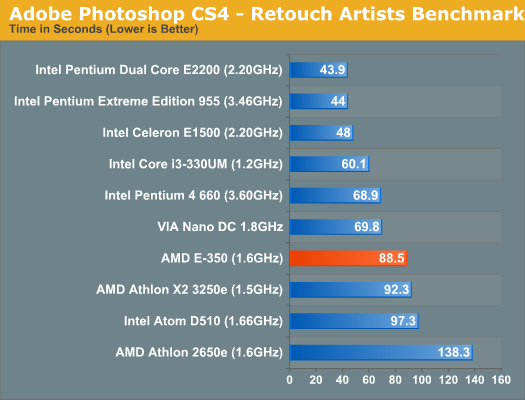
AMD's performance target for Bobcat was 90% of the performance of K8 at the same clock speed and our Photoshop CS4 benchmark shows that AMD can definitely say that it has met that goal. At 1.6GHz the E-350 manages to outperform a pair of K8s running at 1.5GHz in the Athlon X2 3250e. Unfortunately for AMD, Intel's Pentium dual-core running at 2.2GHz is much quicker. Most notebooks in the $400+ range have at least a 2.2GHz Pentium. Even the Atom D510 isn't far behind.
AMD tells me that in general purpose integer tasks, the E-350 should do well and it may even exceed AMD's 90% design target. However in higher IPC workloads, for example many floating point workloads, the E-350 is constrained by its dual issue front end. In these situations, the out of order engine is starved for instructions and much of Bobcat's advantage goes away.

Our x264 HD test has the E-350 performing within 86 - 92% of the Athlon X2 3250e, once again meeting AMD's design targets. Unfortunately, this isn't much faster than an Atom - mostly thanks to Atom's Hyper Threading support. Although not an out of order architecture, Atom gets a healthy efficiency boost by being able to execute instructions from two threads per core. Once again, compared to a 2.2GHz Pentium, the E-350 isn't close. Even VIA's dual core Nano is faster. When it comes to power consumption however, the E-350 can't be touched. I measured max system power consumption at 25.2W while running the x264 encode test. With the exception of the Atom D510, the rest of the desktop platforms here consume much more than that at idle (much less under load).
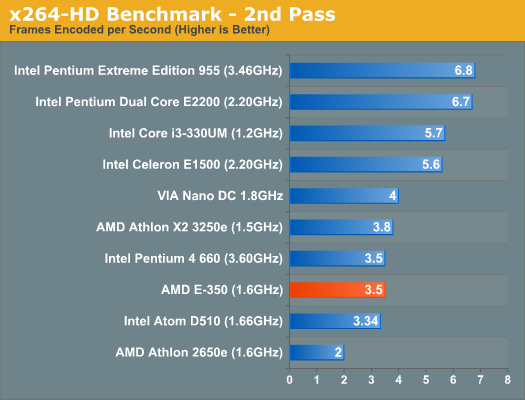
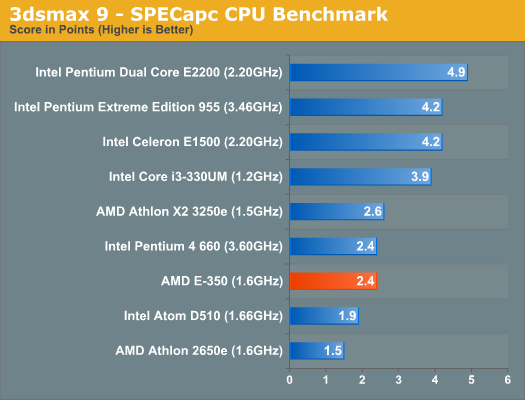
Despite being a offline 3D rendering benchmark, our 3dsmax 9 test does fall in line with expectations. The E-350 delivers 92% of the performance of the Athlon X2 3250e and outperforms the Atom D510 by 26%. Unfortunately for AMD, the Pentium dual-core holds onto a significant performance advantage here. Clock for clock, Bobcat won't be able to do much against anything Core 2 based. The real advantage here will be GPU performance.
Single Threaded Performance
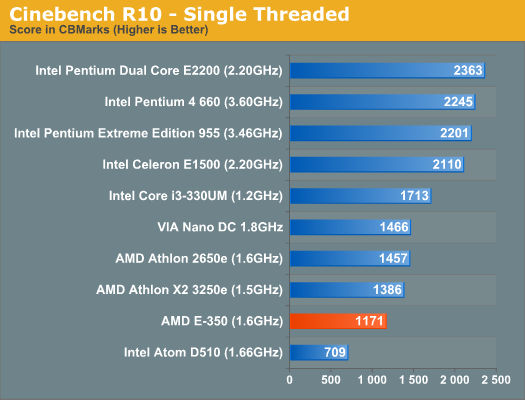
In most of our benchmarks the performance advantage over Atom isn't huge, yet using Brazos is much better than using an Atom based machine. It all boils down to one thing: single threaded performance. Atom can make up for its deficiencies by executing a lot of threads in parallel, but when you're bound by the performance of a single thread the E-350 shines. The E-350 is 65% faster than the Atom D510 in the single threaded Cinebench R10 test. It's this performance advantage that makes the E-350 feel so much quicker than Atom.
The Core i3-330UM manages a 46% performance advantage over the E-350. Even in the ultraportable Arrandale ULV space at lower clocks, AMD still leaves a lot of CPU performance on the table. The advantage here will be cost. A single E-350 is less than 40% of the die area of a Core i3-330UM. You may not get the same CPU performance, but performance per mm^2 is much higher.

In the multithreaded Cinebench test Atom is able to catch up quite a bit, but the E-350 still holds an 11% advantage.
File Compression/Archive Recovery Performance
Our final two CPU tests are both multithreaded and they show the E-350 equaling and falling behind the performance of the 1.5GHz Athlon X2. As we explained earlier, the gap between the E-350 and Atom shrinks as you add more threads to the workload.
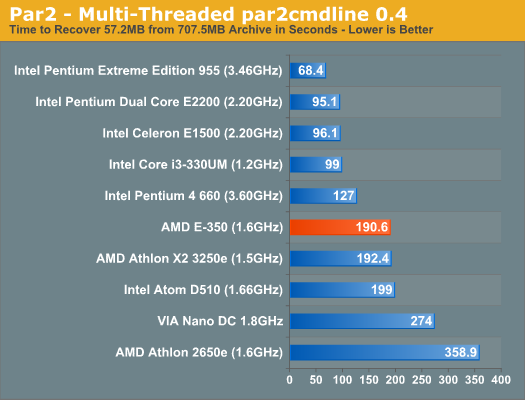
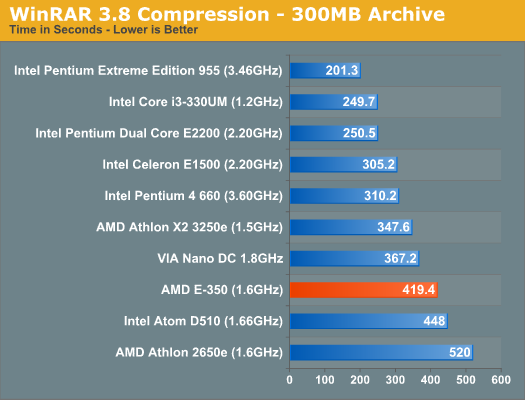










207 Comments
View All Comments
silverblue - Wednesday, November 17, 2010 - link
Oh this is priceless. First we have all the anti-AMD accusations being spouted, and then YOU come in with the anti-Intel ones!rashire - Tuesday, November 16, 2010 - link
This article has me very interested for the potential as a HTPC. I've been looking for a compact (low draw) HTPC solution, I was looking at Atom + Ion combo, but I'm curious how this would preform comparatively. Mostly I'm interested in whether either system has enough power to playing x264 HD video (at a decently high bit rate) while also running par2 without any stutter in playback. (something my current socket 939 HTPC doesn't manage)Would definitely love more coverage on release for HTPC performance.
Brentnall - Tuesday, November 16, 2010 - link
Yes THIS!! +1Also recently been looking into a low power HTPC / File Server setup and the only reason I haven't gone for Atom + Ion yet is because AMD had some new stuff up their sleeves. Got to admit from reading other reviews, it looks pretty damn good compared to the atom, especially the power consumption... just hope the pricing is good too.
Couldn't care less about netbooks and laptops at the moment... more HTPC info please =D
Any ideas when we will start seeing some mobo's based on these chips?
nitrousoxide - Tuesday, November 16, 2010 - link
Current drivers can't give convincing performance boost on x264 HD Video decoding, but AMD will surely give better solutions by the time it ships its APUs. I remembered that when Anand tested the HD5450, it is clearly pointed out that 80 shaders don't have enough computing power to handle Vector Adaptive Deinterlacing, which is a important feature for a HTPC card. Given that HD6310 is slower than HD5450, it isn't a perfect HTPC solution either.nitrousoxide - Tuesday, November 16, 2010 - link
Anyway it could be competitive, though not PERFECT :)mino - Tuesday, November 16, 2010 - link
There will be Zacate boards with x16 PCIe slots for exactly those not willing to wait for Llano or not needing more CPU power.Dark_Archonis - Tuesday, November 16, 2010 - link
Zacate boards with x16 PCIe? What's the point? That's like offering SLI boards for Celeron processors.silverblue - Wednesday, November 17, 2010 - link
And there are i3s and i5s out there with on-die GPUs that have access to an x16 slot. By your logic, what's the point?If you come back and say you were referring to Celerons, please bear in mind there are probably people out there running SLi/Crossfire setups with an Athlon II at the heart. Bang for buck.
Shadowmaster625 - Tuesday, November 16, 2010 - link
Intel CULV processors are ungodly expensive. I dont see how the E-250 will be in the same price class. I did a price check on Core i3-330UM notebooks and they are ALL over $550. It is disingenuous to claim that those intel notebooks will be competing with the notebooks that will carry this tiny little chip.JarredWalton - Tuesday, November 16, 2010 - link
CULV is actually the brand for Core 2 ULV products, whereas ULV parts generally refer to the newer Core 2010 ULV stuff. ULV is certainly expensive, but not because it has to be... rather because Intel can charge that much and people will pay it. Even worse is that you can get nearly the same battery life with regular i3 processors (i.e. ASUS UL80Jt only gets about 30-45 minutes more battery life than the U30Jc). But if you look at CULV, which is where Brazos really competes, there's plenty of stuff selling around the $500 mark (search for Pentium Su4100 laptops).